Jupiter’s moon Europa, an icy world with a subsurface ocean that interests astrobiologists, may actually be hot enough to melt the interior rock and create volcanoes on the ocean floor. Plus, Ryugu, giant planets, fossil discoveries, Martian glaciers, and this week’s What’s Up!
Media
Transcript
Hello and welcome to the Daily Space. I am your host, Beth Johnson. Dr. Pamela is off today taking a well-deserved rest, so I am here to put science in your brain.
As an astronomer, I tell a generalized story on how planets formed that goes sorta like this: It all starts with a giant molecular cloud that one day collapses, dust particles collide and build bigger and bigger structures until small, dust-built, planetesimals emerge. These smash together to form larger objects, gravitationally pull in additional material, or otherwise find ways to grow.
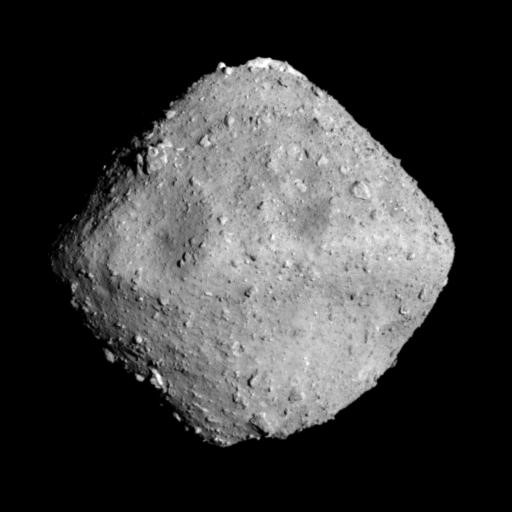
With planets, all traces of that original planetesimal get crushed into oblivion by the weight of materials above. With asteroids, it may be possible that, in some cases, that initial, fluffy planetesimal survives. And it looks like the asteroid Ryugu survived multiple potentially destructive processes!
Thermal imagery of Ryugu by the Hayabusa2 spacecraft revealed the surface is randomly scattered with extremely low-density boulders that are more like giant pumice stones than the high-density boulders we’re used to thinking of. These boulders are so low density, in fact, that they would float in water if given the opportunity!
Researchers think these boulders may be fragments of those low-density planetesimals that once made up Ryugu’s core. We know Ryugu is a rubble pile created during one or more asteroid collisions. These collisions shattered the colliding objects, which then came together as a mixed-up pile of rubble. By literally mixing the core fragments to the surface, this collision process revealed never-before-seen bits of fluffy planetesimals and confirmed at least our big picture view of planet formation is real. And we now know where future space travelers can get pumice-like stone if they need it. This research appears in Nature Astronomy and is led by N. Sakatani.
Testing our theories about other planets without actually have the tools to explore other planets to the greatest of depths is a challenge. We got lucky with Ryugu, and Nature broke it apart for us. With other planets, we just have to do the best we can by simulating their environments in our laboratories. Extreme environments, however, have remained beyond our technical limitations, and our ability to simulate things in a lab is just starting to catch up to our ability to imagine them in software.

In a new experiment at the University of Rochester’s Laboratory for Laser Energetics, researchers used diamond anvils to compress a mixture of hydrogen and helium to pressures like those expected in Saturn’s atmosphere; pressures 40,000 times what we experience on Earth. They then used shock waves from lasers to compress things by another factor of 15-45, and they looked to see what happened. According to study co-author Marius Millot: Our experiments reveal experimental evidence for a long-standing prediction: There is a range of pressures and temperatures at which this mixture becomes unstable and demixes.
Put another way, he says: We discovered that helium rain is real, and can occur both in Jupiter and Saturn. This work appears in Nature and is led by S. Brygoo. We would like to remind all of you not to try singing or dancing in the helium rain because the conditions will kill you.
Laboratory experiments are awesome, but actual data is always better, and some things just can’t be built in our labs – things like entire solar systems.
Ever since we started finding exoplanets in the 1990s, folks have wondered if our system is normal or not. Do other solar systems store their rocky worlds near their suns? Is it typical to have Jupiters and Saturns farther out? Understanding these questions takes time and technology. To confirm the existence of a planet, we really need to wait for it to complete an orbit, and the farther from the Sun an object is, the longer it will take. Jupiter’s orbit is twelve Earth years long, and Saturn’s is 29! Pluto… Well, we haven’t actually seen Pluto complete an orbit yet. It was discovered in 1930 and will take 248 years to orbit.
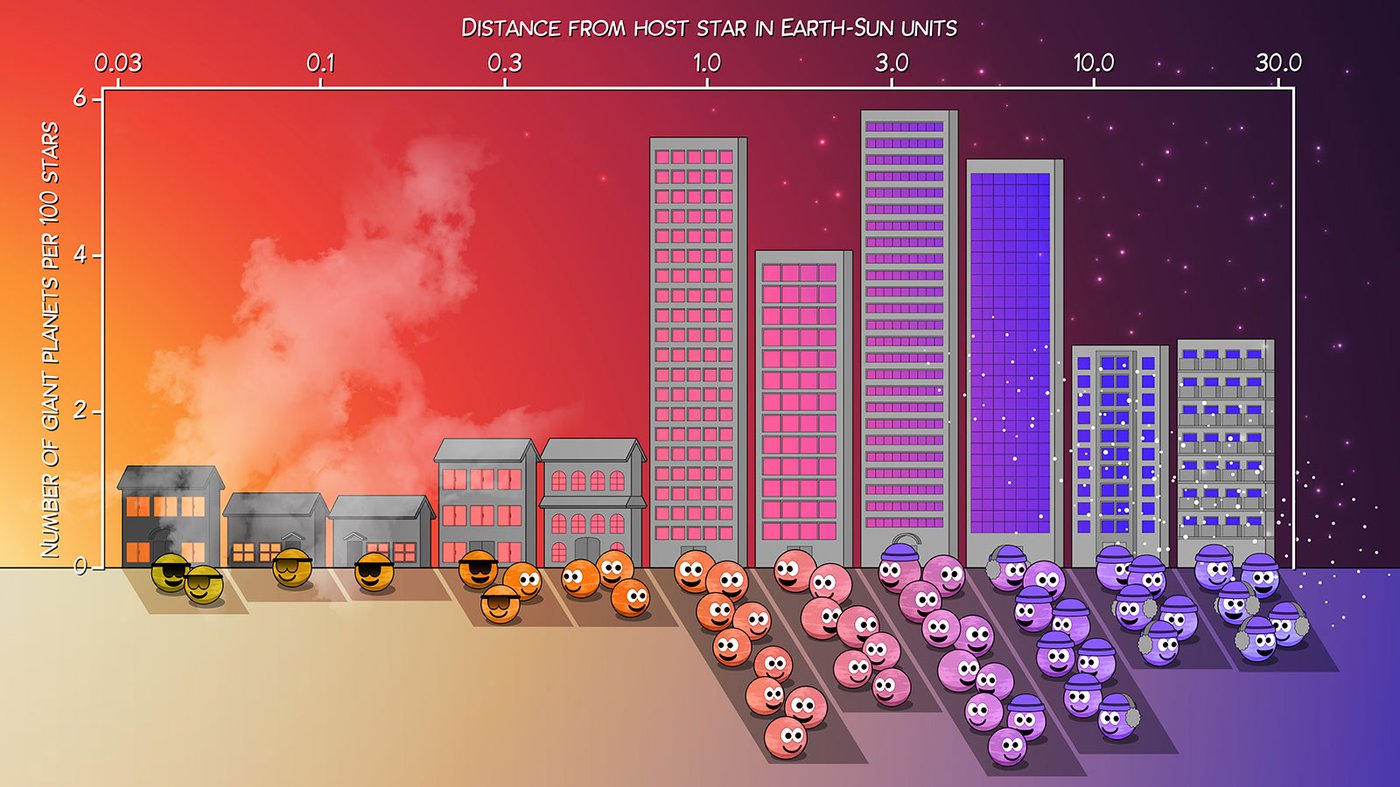
To really understand what is going on, a survey of a large set of stars is required, and this is where the California Legacy Survey comes in. This survey is looking at 719 sunlike stars and is trying to identify the pulls and pushes of orbiting planets reflected in the stars’ motions. This 30-year-old project has released data on fifteen new planets that join its catalog of 177 worlds.
While not sensitive enough to detect distant ice giants like Uranus or Neptune, this survey does see gas giants, and it finds that gas giants are most often found with orbits between the size of Earth’s orbit and 10 Earth orbits. This shows our solar system is pretty typical in its planetary placement, at least in comparison to other systems we can see. With more time, and more sensitive instruments, we’ll be able to see more distant planets and a wider range of planet masses.
This is a reminder that astronomy is a long game, and sometimes the experiments and spacecraft started by one generation are completed by future generations.
Understanding the history of our own Earth is a bit easier than understanding the history of other worlds. On a good day, a random person walking across a random field or along a random cliff face has a non-zero chance of discovering fossils sticking out of the earth. The tongue twister “she sells seashells by the seashore” actually tells the real-world story of Mary Anning, a self-made expert in fossils who made her living making careful observations and then collecting and selling fossils from the cliffs near Dover.
While it’s hard to imagine this kind of “huh, there is a massive fossil find in front of me” discovery today, it can happen. In the summer of 2020, a park ranger named Greg Francek was walking near the Mokelumne River watershed outside Sacramento and spotted what appeared to be a petrified tree. And then another petrified tree. And eventually, even fossils of animals all randomly scattered in what he and others would come to realize is a petrified forest that dates back to the Miocene epoch, about ten million years ago.
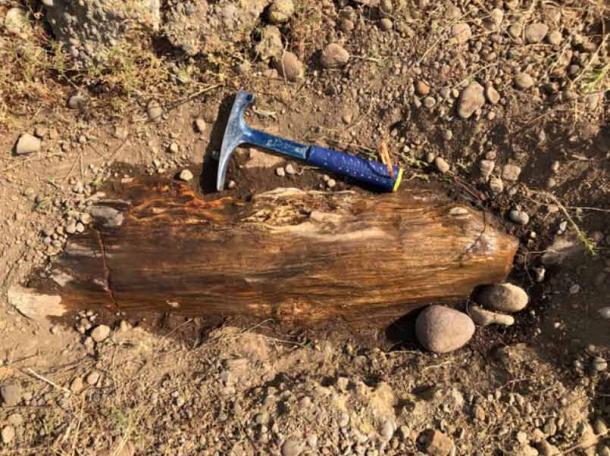
This epoch is best known for the emergence of giant mammals, with early versions of the horse, camel, and sloth littering the fossil record. And mastodons. This was the age of mastodons, and in this newly discovered petrified forest, Francek and a team from the Cal State Chico campus discovered a fully intact mastodon skull with the long tusks still attached.
This COVID-lockdown era discovery was protected initially by luck, and now will be protected under the United States Paleontology Preservation Act. In the coming months, researchers from additional institutes will join the search for this new fossil find.
This is a reminder that the only thing separating a scientist from a non-scientist is the reporting of data. It is unknown how many myriad hikers had seen this park’s petrified wood and maybe even pocketed a few fossils. All it took to make this discovery was the curiosity to ask “what is this” and the scientific follow through to report what was found.
Not every fossil discovery is made this easily. In some cases, in the opposite of the scientific method, folks see fossils, curse, and pretend they aren’t there. Those people are usually the folks trying to build a road, dig a new foundation, or burrow into the ground for any of many other reasons where delays will cost revenue. To prevent these accidental discoveries from getting ignored, many places in the world require a paleontologist or archeologist to be present at construction sites. This has led to a weird situation for one soon-to-be-closed garbage dump and its associated paleontologists in Spain.

The Can Mata landfill in Catalonia, Spain, digs vast pits in sandy soil and then fills these pits with what the locals deride as extremely stinky garbage. During the 24/7 excavation that occurs, researchers from the Miquel Crusafont Catalan Institute of Paleontology watch for solid bits in the loose soil and pause the dig on a regular basis to collect bits of bone and sometimes even massive pieces of skeleton. In this garbage dump, the excavation comes as a necessary part of waste storage, and researchers are able to get samples of the past they would otherwise lack the resources to recover.
So far, more than 70,000 fossils have been recovered, including some of the only examples or most complete examples of various early primates that are known. According to an article in National Geographic, their finds include the discovery of what is called a chalicotherium: a tall, knuckle-walking, clawed ungulate that looks like a bizarre mix of giant sloth, bear, horse, and gorilla. They have also found one of the only early flat-faced primates, which researchers think is a sign of convergent evolution leading to head shapes like ours more than once.
While it is a bit terrifying to think about how many fossils are either broken in the excavation of this garbage dump or just plain missed in the rapid digging, what is a bit more horrifying for researchers is the knowledge that local attempts to get this dump closed down could end their ability to recover fossils. Located relatively near Barcelona in a fairly densely populated area, locals have begun protesting the dump and its smell. If the dump is no longer an active waste facility, it will be sealed off for safety, and the paleontologists won’t be able to dig. Not that they’d have the budget for the dig.
This is the kind of science that gives me extremely mixed emotions. Humanity’s production of garbage is vast and environmentally destructive. No one wants to live near a dump, and I feel for these folks. But the science that is being done is amazing. I guess, fundamentally, the sadness comes from the realization that there will always be more funding to dig to build houses, roads, and garbage dumps than there will ever be to just dig for the sake of science.
Hunting for fossils isn’t just an Earth-based activity anymore. At least, not in theory. There are a lot of people discussing the possibilities for life on Mars these days, and one of those discussions is about finding evidence of past life. A few people are even talking about finding evidence of current life. But none of our rovers are in place or equipped or even allowed to intentionally look for physical signs of life. Perseverance is in a lake bed, it’s true but is not allowed to venture over to the nearby river delta where microbial life might have been abundant. While there is an agreement to keep spacecraft free of biological contamination, it’s never a guarantee, so scientists act out of an abundance of caution.
Oddly enough, there’s also a push to send humans to Mars so that they can do the research that the rovers cannot. After all, there’s only so much onboard analysis we’ve managed to place on these rovers, and human hands and eyes are an incredible scientific tool. We have a lot of problems to solve before we can send people to the red planet, though. It’s not habitable for us by any stretch. And, as always, one of the things on the checklist is access to water.
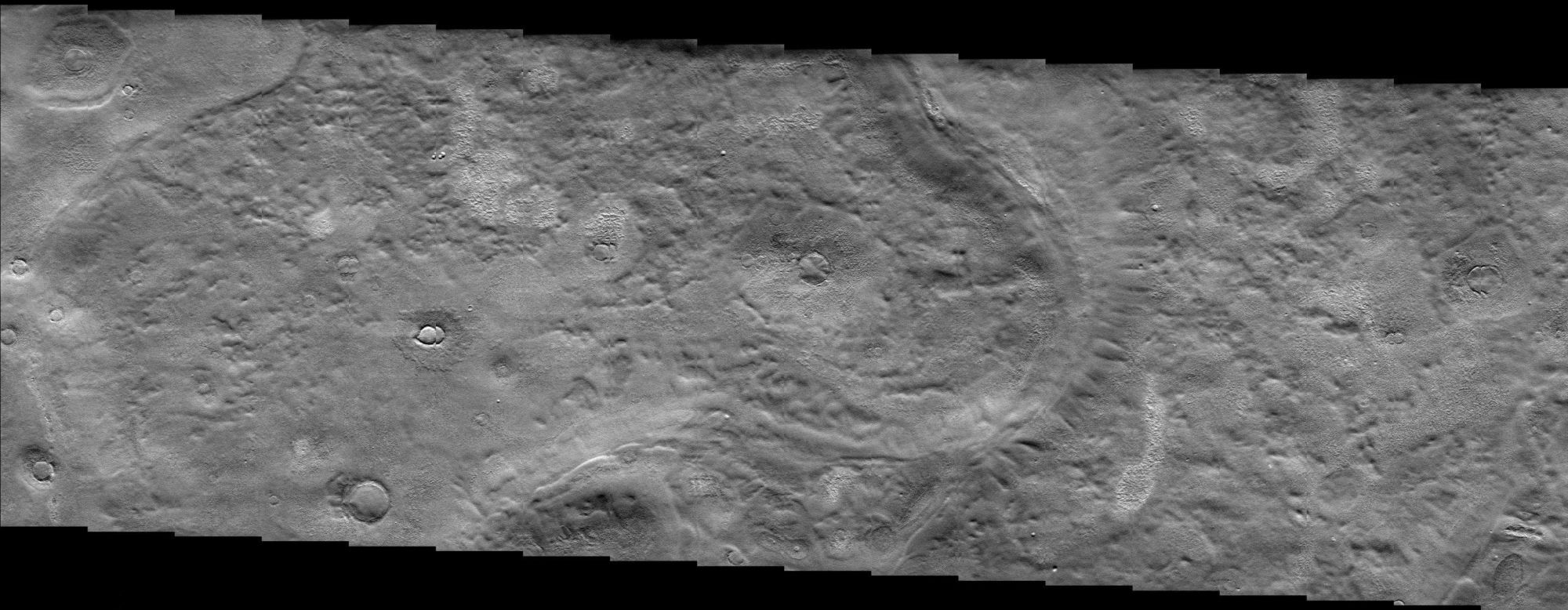
New research published in Icarus and conducted by graduate student Shannon Hibbard at Western University in Ontario provides evidence for past ice streams under the surface. Not only that, but the ice streams are in a relatively flat, low-lying region of Mars called Arcadia Planitia, which makes it a potential landing spot for future astronauts. Hibbard explains: We have not seen anything quite like this on Mars, so we look to Earth where streams of ice within ice sheets can exist with no obvious control from surface topography. On Earth, these are known as ice streams.
However, Hibbard and her team cautioned that these results are not evidence of water on Mars. We still don’t fully understand what causes ice streams here on Earth. Hibbard goes on to explain: …it is likely that subglacial water plays an important role in ice stream initiation and flow, especially where surface slope is low, like what we see at the sinuous features in Arcadia Planitia. So, it is possible that at some point subglacial water was present at this location on Mars, but it is unclear how much and for how long.
Speaking of water and possible life on other worlds, one of our other favorite icy moons is in the news again. An international team of researchers has published new work in Geophysical Research Letters detailing observations and modeling of Jupiter’s moon Europa and how the tidal forces from Jupiter and the other Galilean moons may cause enough inner heating for Europa to have volcanoes on its seafloor.
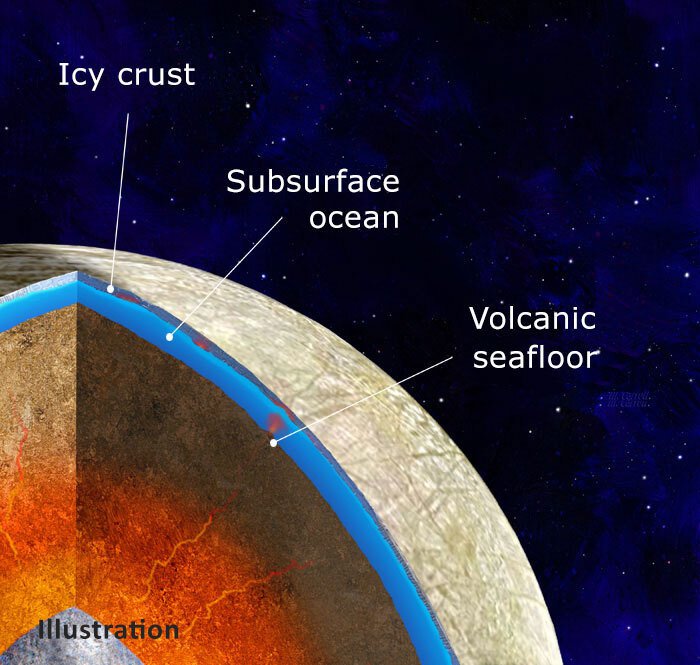
Europa is an icy moon with a vast subsurface ocean, and the reason the tiny world, not much smaller than our own Moon, is the subject of so much interest and speculation is that that ocean could have seafloor volcanoes similar to what we have on Earth. On Earth, those volcanoes also create hydrothermal vents that spew hot, metallic clouds, and life can be sustained on that material. If it happens once, it could happen elsewhere. The big question has been whether or not Europa has enough internal heat to create a magma layer.
And this new research says yes. Per the press release: The research models in detail how Europa’s rocky part may flex and heat under the pull of Jupiter’s gravity. It shows where heat dissipates and how it melts that rocky mantle, increasing the likelihood of volcanoes on the seafloor.
All of this work is being done in anticipation of the Europa Clipper mission, which is currently scheduled to launch in the mid-20s and arrive at Europa in 2030. Between this news, the upcoming mission, and all the work being done on Mars, I think we’re going to find evidence of at least microbiologic life on another world in my lifetime.
What’s Up
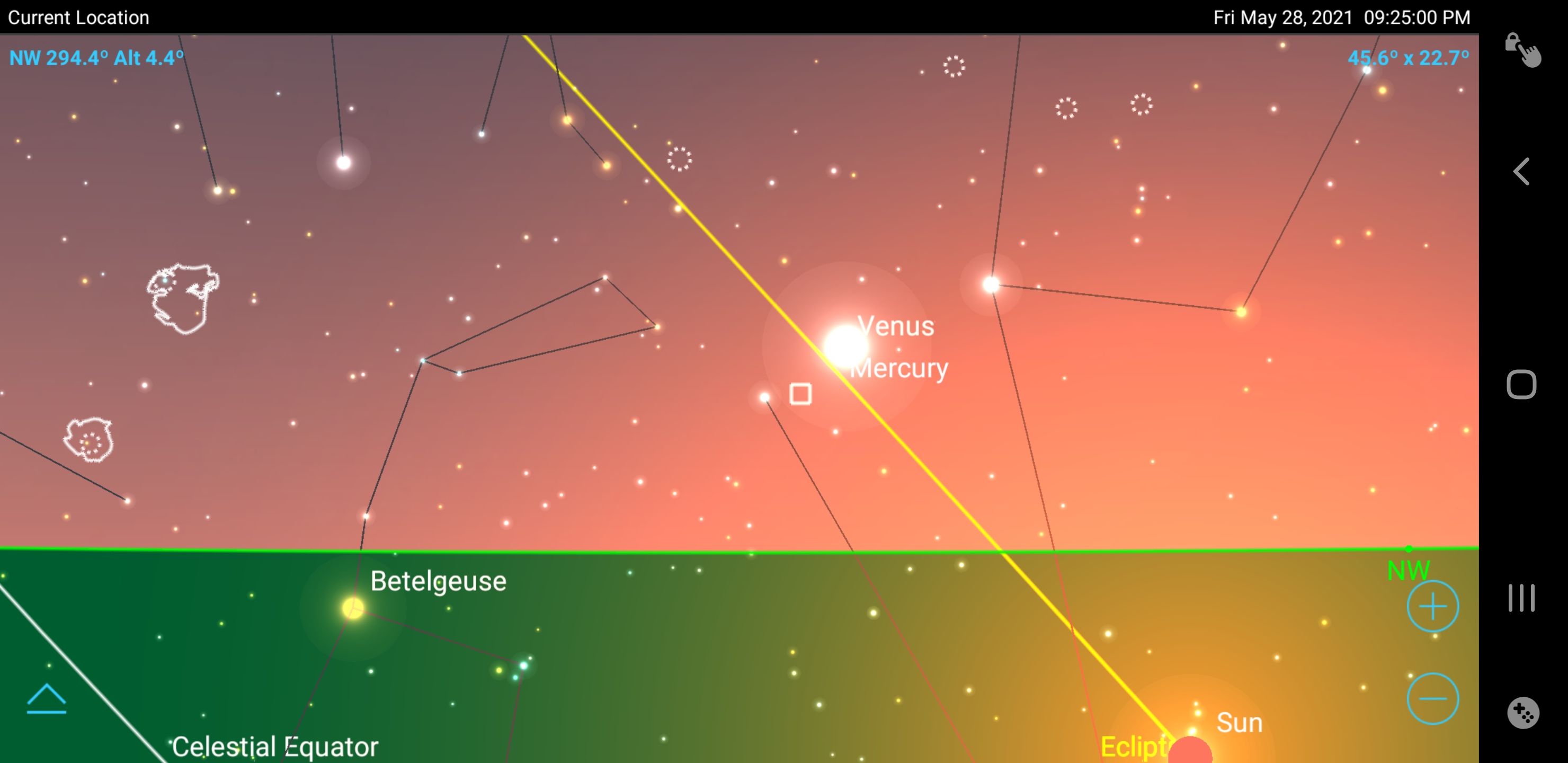
If you didn’t get out the last two weeks and check out Mercury, there is another cool event coming up this weekend. It’s actually going to be more difficult because it’s going to be in close conjunction with Venus. This will be the closest visible conjunction until 2033. You’ll probably need at least binoculars to differentiate the two, though, as Venus is just so bright. And Mercury is in a waning crescent, so it’s less bright than when we sent you all out to look earlier this month. However, if you can get a clear view of the western horizon at dusk, give this pair a look, and please share any pictures you happen to take. You can tag us on Twitter where we are at CosmoQuestX.

If you live near New York City, now is the time to go see a curious phenomenon called Manhattanhenge, where the Sun lines up nearly perfectly along 42nd, 34th, and 13th Streets in Manhattan. This is a twice-a-year event, and this year, the first occurrences (they come in pairs) are on May 29 and May 30 at about 8:10 pm Eastern. The next time this phenomenon occurs will be in July on the 12th and 13th at 8:20 pm Eastern.
This is a pretty neat little happenstance. Scientific American explains:
The phenomenon is based on a design for Manhattan outlined in The Commissioners’ Plan of 1811 for a rectilinear grid or “gridiron” of straight streets and avenues that intersect one another at right angles. This design runs from north of Houston Street in Lower Manhattan to just south of 155th Street in Upper Manhattan. Most cross streets in between were arranged in a regular right-angled grid that was tilted 29 degrees east of true north to roughly replicate the angle of the island of Manhattan. And because of this 29-degree tilt in the grid, the magic moment of the setting sun aligning with Manhattan’s cross streets does not coincide with the June solstice but rather with specific dates in late May and early July.
So if you’re in the area, give this view a chance. We’ll have links to where to see it from in our show notes on DailySpace.org.
For now, though, this has been the Daily Space.
Learn More
Boulders Tell Story of Asteroid Ryugu’s Formation
- ISAS press release
- “Anomalously porous boulders on (162173) Ryugu as primordial materials from its parent body,” N. Sakatani et al., 2021 May 24, Nature Astronomy
Helium Rain Falls in Laboratory Saturn
- LLNL press release
- “Evidence of hydrogen−helium immiscibility at Jupiter-interior conditions,” S. Brygoo et al., 2021 May 26, Nature
Planetary Census Finds Jupiters Prefer Outer Solar Systems
- Caltech press release
- “The California Legacy Survey I. A Catalog of 177 Planets from Precision Radial Velocity Monitoring of 719 Nearby Stars over Three Decades,” Lee J. Rosenthal et al., to be published in The Astrophysical Journal Supplement (preprint on arxiv.org)
- “The California Legacy Survey II. Occurrence of Giant Planets Beyond the Ice line,” Benjamin J. Fulton et al., to be published in The Astrophysical Journal Supplement (preprint on arxiv.org)
Lucky Hiker Discovers Petrified Forest With Fossilized Animals
- Trove Of Fossils Discovered In Mokelumne River Watershed Near Valley Springs (Good Day Sacramento)
- California Park Ranger Discovers Massive Cache of Miocene Epoch Fossils (Ancient Origins)
Garbage Dump Reveals Fossils While Making Room For Trash
- UAB press release
- The priceless primate fossils found in a garbage dump (National Geographic)
- “Oldest skeleton of a fossil flying squirrel casts new light on the phylogeny of the group,” Isaac Casanovas-Vilar et al., 2018 October 9, eLife
Ice Stream Features on Mars May Signal Subsurface Water
- Western University press release
- “Evidence for widespread glaciation in Arcadia Planitia, Mars,” Shannon M.Hibbard et al., 2021 January 9, Icarus
Europa’s ocean floor could host volcanoes
- NASA JPL press release
- “Tidally Induced Magmatic Pulses on the Oceanic Floor of Jupiter’s Moon Europa,” Marie Běhounková et al., 2020 December 22, Geophysical Research Letters
What’s Up: Mercury-Venus Conjunction and Manhattanhenge
- In Late May, Closest Mercury-Venus Conjunction Until 2033 (EarthSky)
- It’s Almost Time For Manhattanhenge (EarthSky)
- Manhattanhenge: What It Is, and How to See It (Scientific American)
Credits
Written by Pamela Gay and Beth Johnson
Hosted by Beth Johnson
Audio and Video Editing by Ally Pelphrey
Content Editing by Beth Johnson
Intro and Outro music by Kevin MacLeod, https://incompetech.com/music/


 We record most shows live, on Twitch. Follow us today to get alerts when we go live.
We record most shows live, on Twitch. Follow us today to get alerts when we go live.